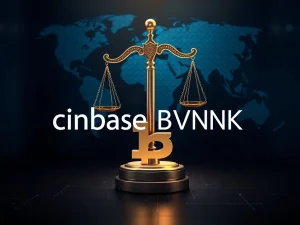Landmark Stablecoin Framework: SMBC, Ava Labs, Fireblocks Unite in Japan

Exciting developments are unfolding in the crypto space as traditional finance bridges with blockchain innovation! Sumitomo Mitsui Financial Group (SMBC), a major Japanese financial institution, has joined forces with Ava Labs (the team behind Avalanche), and Fireblocks, a leading digital asset infrastructure provider. This powerful trio has signed a Memorandum of Understanding (MoU) to explore and build a robust stablecoin framework right in the heart of Japan. What could this mean for the future of digital assets and the global financial landscape?
Revolutionizing Finance in Japan with a Stablecoin Framework
This collaboration is a significant step towards mainstream adoption of cryptocurrencies, especially within a highly regulated market like Japan. The MoU signifies a commitment from these industry giants to develop a practical and compliant stablecoin framework. Let’s break down what this partnership entails:
- Strategic Alliance: SMBC, with its financial prowess, teams up with Ava Labs’ blockchain expertise and Fireblocks’ secure infrastructure to create a comprehensive stablecoin framework.
- Focus on Stability: The framework will primarily explore stablecoins pegged to both the US dollar and the Japanese yen, offering stability in the volatile crypto market.
- Real-World Asset Integration: Beyond simple transactions, they aim to use stablecoins as a settlement mechanism for tokenized real-world assets (RWAs) like stocks, bonds, and real estate. Imagine trading tokenized Japanese real estate using a Yen-pegged stablecoin!
This initiative comes at a crucial time. Globally, regulation around stablecoins is intensifying as nations recognize their potential and risks. Venture capitalists are also keenly watching the stablecoin sector, anticipating significant growth as countries integrate these digital currencies into their financial strategies.
Why is Stablecoin Regulation in Japan and Globally So Important?
Stablecoins are not just another cryptocurrency; they are designed to maintain a stable value, typically pegged to a fiat currency like the US dollar. This stability makes them attractive for everyday transactions and as a bridge between traditional finance and the crypto world. But why the regulatory focus?
- Financial Stability: Because stablecoins aim to mirror fiat currencies, their stability (or instability) can have ripple effects on the broader financial system. Regulation is crucial to ensure they truly are stable and don’t pose systemic risks.
- Combating Illicit Activities: Like any financial tool, stablecoins can be misused. Regulation helps prevent money laundering and other illicit activities.
- Consumer Protection: Clear rules and oversight are necessary to protect users of stablecoins, ensuring transparency and accountability.
- National Digital Asset Strategy: Countries like the US and now potentially Japan are viewing stablecoins as central to their digital asset strategies, aiming to lead in the evolving financial landscape.
The US Dollar’s Role and Stablecoins: A Global Perspective
The article highlights a fascinating point: the role of stablecoins in maintaining the US dollar’s global hegemony. According to US Treasury Secretary Scott Bessent, robust stablecoin regulation is vital for President Trump’s ambition to make the US a crypto leader. Here’s the connection:
- Dollar Hegemony: Stablecoins, particularly those pegged to the US dollar, can expand the dollar’s reach and usage globally.
- US Treasury Bills: Many centralized stablecoins are backed by reserves that include short-term US Treasury instruments. Tether, a major stablecoin issuer, is now a significant holder of US Treasury bills, surpassing even some sovereign nations.
- Yield and Controversy: Stablecoin issuers generate yield from these Treasury holdings. There’s ongoing debate about whether this yield should be shared with stablecoin holders. While some, like Coinbase CEO Brian Armstrong, advocate for yield distribution, others, like Senator Kirsten Gillibrand, raise concerns about disrupting traditional banking and lending.
Stablecoin market overview underscores the rapid growth and importance of these digital assets. With a total market cap exceeding $227 billion and over 155 million holders worldwide, stablecoins are no longer a niche crypto concept but a significant force in the financial world.
What Does This Mean for the Future of Digital Assets in Japan and Beyond?
The SMBC, Ava Labs, and Fireblocks collaboration is a powerful signal. It indicates that traditional financial institutions are taking digital assets, and particularly stablecoins, very seriously. This initiative in Japan could pave the way for:
- Increased Adoption: A well-regulated and functional stablecoin framework can boost the adoption of cryptocurrencies in Japan, both for institutional and retail users.
- Innovation Hub: Japan, already a tech-forward nation, could become a leading hub for stablecoin innovation and development.
- Global Impact: The framework developed in Japan could serve as a model for other countries looking to integrate stablecoins into their financial systems.
- RWA Market Growth: Using stablecoins for settling tokenized real-world assets could unlock significant liquidity and efficiency in markets for stocks, bonds, and real estate.
In conclusion, the MoU between SMBC, Ava Labs, and Fireblocks is a landmark development for the stablecoin framework and the broader digital asset landscape in Japan. As regulation evolves and adoption grows, stablecoins are poised to play an increasingly crucial role in the future of finance, bridging the gap between the traditional and the decentralized worlds.







